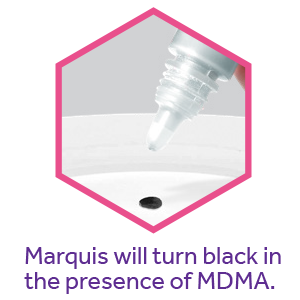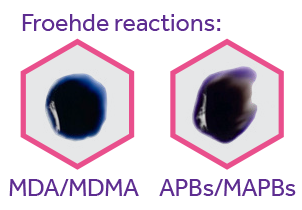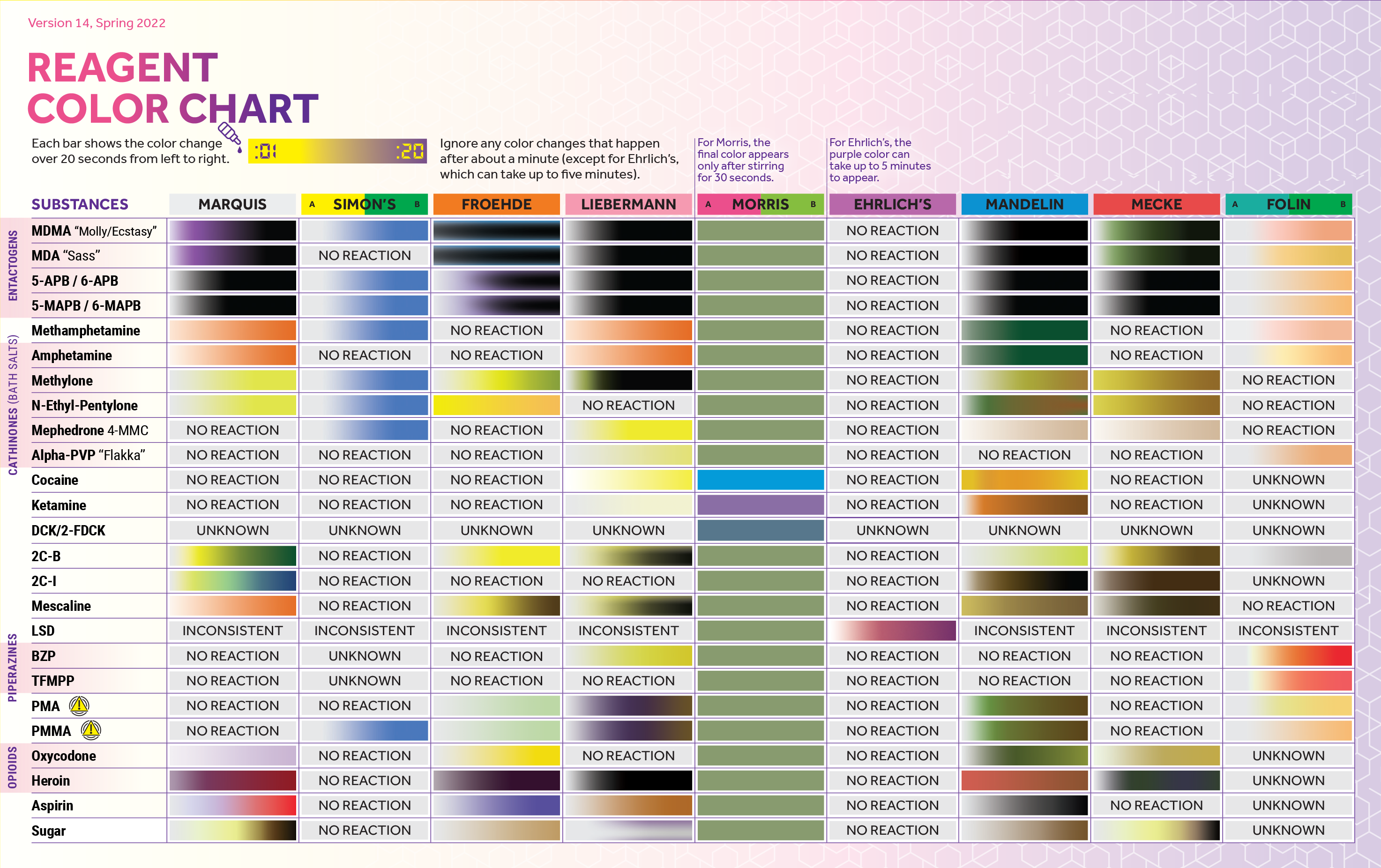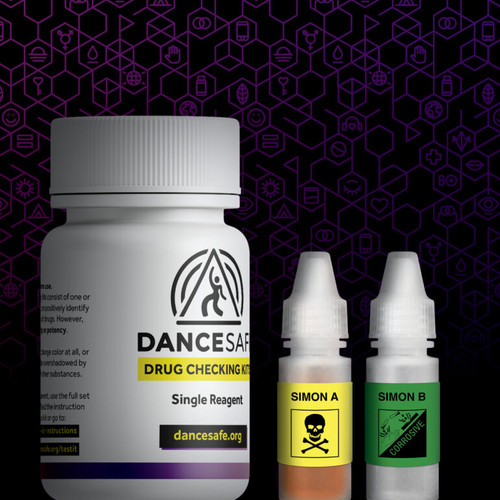Now at a lower price!
A three-step kit to identify MDMA (or MDA, or the APBs) in Ecstasy tablets and Molly. Contains Marquis, Simon’s and Froehde reagents. Each kit performs 50-75 tests. Includes one free fentanyl testing strip.
WHY TEST MDMA?
There are many different drugs being sold under the names “Molly” or “ecstasy.” Whether you have pressed pills, crystals, or powder, there is no way to tell what drug you have without testing it first. Hundreds of people have died and thousands more hospitalized after ingesting what they thought was MDMA, but ended up being something else.
HOW TO TEST MDMA
1 Start with Marquis reagent.
In the presence of MDMA, Marquis will quickly turn to black (within seconds). You might also see purple at first.
2 Next use Simon’s reagent.
Use Simon’s to distinguish between MDMA and MDA. If Simon’s turns blue, it’s likely MDMA (but it still could be one of the MAPBs). If there is no color change, it’s likely MDA (but it still could be one of the APBs).
3 Next use Froehde reagent.
A black reaction with a possible blue hue around the edges indicates MDA (or MDMA if Simon’s turned blue). A purple reaction (or black with a purple hue around the edges) indicates one of the (M)APBs.

WHAT ARE REAGENTS?
Reagents are chemicals that change color when they come into contact with certain drugs, enabling you to detect their presence in a sample. Reagents cannot, however, detect every drug, nor can they tell you how pure or potent your drugs are. Even if you get the expected color reactions for the drug you want, there could still be one or more other drugs present. This is because:
- Not all drugs change color with reagents.
- Darker colors may overshadow lighter colors.
- A very tiny quantity of a drug may not produce a visible color change.
Despite these limitations, reagent testing is useful for identifying the presence of specific drugs, and——most importantly——for determining whether your sample does not contain the drug you want.
REAGENTS CAN
- Detect the presence of certain drugs
- Inform your decision about whether or not to consume a drug
REAGENTS CANNOT
- Tell you how potent your drugs are
- Tell you if your drugs are pure
HOW TO USE REAGENTS?
1 Place a tiny amount of your drug onto a white, ceramic plate. Make it about the size of a pinhead. We will refer to this as the “sample” of your drug. For pressed pills, use a sharp knife to scrape the powder off the side. For blotter paper, cut off a tiny piece of the corner. For liquid drugs, place one drop onto the plate.
2 Carefully place one drop of reagent onto the sample. Do not let the bottle touch the sample or you will contaminate the entire bottle of reagent. If you are using a 2-bottle reagent such as Simon’s, Folin, or Morris, place one drop from bottle A and then one drop from bottle B onto the same sample.
3 Observe the color change and compare with the enclosed color chart. Most reagents will change color within twenty seconds.
- Ehrlich’s reagent can take up to 5 minutes.
- Morris reagent needs to be stirred (use a toothpick or the sharp point of a knife).
The final color will appear after stirring for a full 30 seconds.
4 Repeat. Most drugs need to be tested with more than one reagent. When using multiple reagents, put the cap back on the first reagent and repeat the process with the next reagent using a new sample from the same batch that you’re testing.
5 Clean up. Use baking soda to neutralize 5 the chemicals, then wash the plate with soap and water.

THE COLOR CHART
Below are reactions for some of the most commonly used drugs. For more color reactions, see this reddit page.
STORAGE AND HANDLING
Keep reagents out of heat and sunlight to prolong the shelf life. If stored in a refrigerator or freezer, most reagents will last a year or longer. (Make sure to thaw them out to room temperature before use.) Dispose of unused reagents at a hazardous waste facility.
- Mandelin reagent starts out light orange in color and turns cloudy yellow after 3-4 weeks. This is okay. Make sure to shake the bottle before each use.
- Marquis and Mecke reagents begin as clear liquids and gradually darken over time. This is okay. They are only expired when the liquid in the bottle becomes so dark that you can no longer see the color reaction.

If contact is made with the skin, wash with water immediately. If it gets in the eyes, flood the eyes with water for at least 10 minutes, holding them open. If accidentally ingested, rinse the mouth. Do not induce vomiting. Drink water and seek immediate medical attention.
Please note: We cannot accept any returns or exchanges with Dancesafe Reagents and Kits as the outer packages, containers and reagent bottles are not tamper proof. It's really important (potentially life and death) that every reagent or kit we provide is fresh from Dancesafe and has not been tampered or opened before reaching any customers. Thank you for understanding. We recommend choosing carefully, and please call us on 0800-HEMPSTORE if you have any questions, before you order. You can rest assured any reagent or kit you purchase has come direct from Dancesafe to us and then to you.













